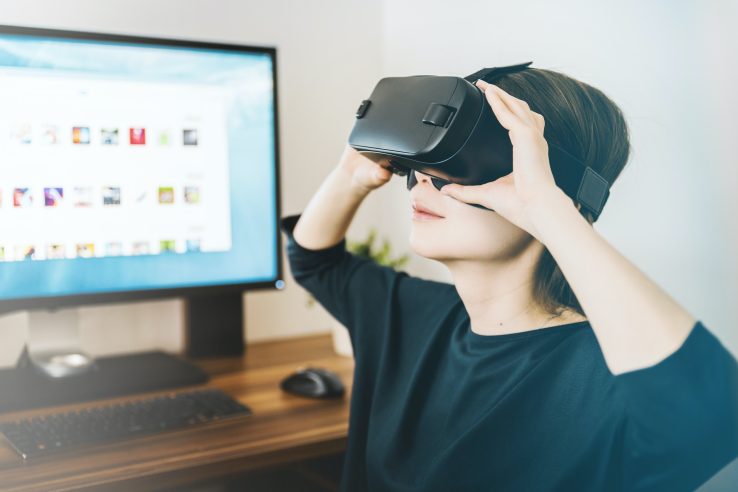The smooth and sturdy cover of a freshly bought book opens, and the magical scent of a new book wafts towards me, smelling the same as it did in my childhood. The text is neatly typed from left to right, the thin pages turn swiftly, and the imagination is working full steam ahead. Just like always.
Well, almost. In the front of this book lays a printed QR code, on the receipt a randomized password. With my Virtual Reality controller, I scan the code, input the password, and suddenly I’m transported into the book itself. I soar above the clouds on a dragon’s back, I read next to a fire with Jane Austen, and I waltz beneath brightly colored truffula trees.
This is the current state of the book. While many prefer to simply buy the online versions of popular novels, true bibliophiles will spend the extra money to obtain the analog versions as well. With the proliferation of Virtual Reality, or VR, the publishing of books has flourished in digital formats. This development was predicted decades in the past, as educator Amaranth Borsuk claimed that “the potential of digital devices to serve as book interfaces has been present since the early days of portable computing” in her 2018 novel The Book (p. 200). Readers can now buy anything from an ebook to a fully immersive interactive experience. Each different form, of course, has its own price tag. A digital text is the least expensive, followed by the print book itself, then varied digital interactive experiences. The latter of the three has only become commonplace within the last decade, but innovations in its sphere have grown immensely. Each genre of book has seen different digital iterations, with each blurring the line between “reader” and “user”. Let’s examine the most popular genres available in modern digital formats: textbooks, classical novels, fantasy stories, and children’s books.
Historically large and imposing objects, textbooks have a reputation of putting their readers to sleep. However, in the modern age, professors now utilize what we now know as textbooks for far more than just reference material. Now, textbooks are seen as incomplete without expansive digital components that go beyond simple PDF versions of the text. A fantastic example is a physics textbook. Now, readers interface with interactive diagrams of falling objects and forces embedded into the digital text instead of simple images printed in a book.

Perhaps most important development is the digital lab feature provided with most of these books. Within this feature, students can conduct real-time experiments just as they would in reality, yet without any of the inherent dangers or costs of using physical matter. While analog copies of textbooks are still available, many teachers require these digital versions of the text for their lab instruction unless a student has an accessibility accommodation. These modern textbooks can also be updated online to reflect more accurate information, though this upgrading process does cost users. With these innovations of the simple textbook, gone are the days of static diagrams and immutable information.
Classical novels have truly stood the test of time. Greats like Dickens, Shakespeare, and Austen still captivate audiences centuries after their deaths. Part of their popularity stems from the fact that they have always been on the cutting edge of technology. This is due to their copyright-free nature, as artists have used them to experiment and develop the digital landscapes and experiences we are so used to today. In fact, according to Borsuk, the very first audiobooks ever produced were recordings of public domain works such as poems by Edgar Allen Poe (p. 205). While these books used to simply be available as print novels, audiobooks, or free ebooks, they have now been transformed beyond their pages. For example, readers can now experience A Christmas Carol as it was first designed to be: read by Charles Dickens. Now, the real Dickens is of course not actually reading this book, but AI technology, combined with first-hand accounts of people viewing his plays, has led to modern populations being able to listen to and view Dickens performing his stories, just as he would have far into the past. A similar system has been developed to experience Shakespearian plays, where you can sit within the Globe Theatre and watch as three witches circle a scheming Macbeth. Now, these authors created works of writing that were inherently meant to be acted out, but what about novels that are less interactive? Readers don’t have to look far, as many authors have been AI generated to read their classic novels to you by a fireside. Users can visit Jane Austen in her home as she enthralls you in Pride and Prejudice, or travel to a Spanish villa to hear a recounting of Don Quixote. These experiences are much like audiobooks, simply transformed for the modern age.
Words cannot always aptly describe truly awe-inspiring scenes, and authors are tasked with simply doing the best that they can. However, now authors can coordinate with visual effects artists and 3D modelers to bring their books to life. This is most prevalent in fantasy and science fiction novels. These books are not AI generated movies (though that media has certainly flourished in the past decade), but rather settings surrounding the user as they read. The process is best described by Borsuk when she states that “Book artists have explored [the] spaciality [of books] by creating virtual realities that puncture the two-dimensional plane of the page,” (p. 149). For example, readers with access to the interactive digital version of Eragon by Christopher Paolini are presented with a myriad of breathtaking scenes that shift as you continue with the novel. What better place to read about Farthen Dur than inside the mountain city itself, gaping in awe at the sheer size of the underground civilization? Readers will also find themselves riding upon the great blue dragon Saphira’s back, navigating the seas with Roran Garrowson as he travels in search of the Ra’zac, or reading underneath the grand trees of the elven city Du Weldenvarden. In addition to photo-realistic visuals, ambient noise relating to the location is also incorporated. These settings are crafted to supplement the imagination, not replace it, as the actions in the book do not play out in real time. Rather, these scenes set a tone and a mood for readers to truly immerse themselves into the books as they read. While readers of the past had to seek out quiet spaces to truly become engrossed in a book, modern readers can simply put on their VR headsets.

Bright colors, distinctive shapes, and silly storylines: these are the hallmarks of children’s story books. Traditionally made out of thick cardboard printed with vivid inks, this form of writing has, like all other forms, become available in interactive digital versions thanks to virtual reality. Many headsets that are made for children will come with children’s stories preprogrammed into them, but they can also be purchased online or alongside analog versions just like most every book.

Pop-up children’s books have perhaps translated to the digital world the best. Instead of cardboard and paper bushes rising up from the page for a bunny to run past, they burst up from a digital landscape. In many of these books, the words will be displayed on the bottom of the screen as a read-along with the narrator. This moves away from what other genres do, as most others leave a digital book in hand for users to use. However, this format leaves the child’s hands free to interact with the scenery or animals present with the book while also learning how to read from the bottom text. Of course, there is a much larger demand for purchasing analog books alongside digital ones in this genre, as parents can then use them as bedtime stories for their children.

We’ve explored how various books have transformed in the digital world, but where does that leave publishers? Why would readers ever want analog versions of books when interactive ones are available? Well, many adults still prefer the experience of reading an analog book, a joy that has echoed throughout centuries. No matter what innovations have been made or how technology has advanced, the analog book has remained steadfast and popular to this day. It’s classic feel, freedom, and inexpensive nature lends itself easily to readers everywhere. Publishers have grown to realize this, which is why they often sell package deals for both analog books and their digital formats. Large publishers now have entire departments dedicated to creating these interactive formats alongside departments focusing on the physical books. Smaller publishers may outsource the creation of their digital media, but will still prioritize the physical medium. There is a security with publishing analog books, as each new generation realizes that these material objects contain just as much magic as their online counterparts.
The book has come a very long way. Its use as a source of knowledge and entertainment has stood the test of time. While digital worlds are being created to allow readers to experience books like never before, the analog book still remains strongly in publication. Even if these volumes do not allow you to watch Dickens perform, ride on the backs of dragons, or chase a rabbit through bushes, they prompt your imagination to visualize it just the same. Whether readers are opening a physical tome or a digital one, whether they smell the scent of a new book or feel the grip of their VR controllers, they are unlocking a magic that book readers have experienced since words were first put to the page.
Citation: Borsuk, Amaranth. The Book. Cambridge, MA: The MIT Press, 2018.
